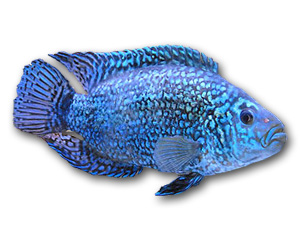Jack Dempsey

Quick Stats
| Size | 10" (25cm) |
|---|---|
| Tank | 180 litres + |
| Swimming Area | Bottom, middle |
| Ph | 7.0 to 8.5 |
| Temperature | 77ºF to 82ºF(22-30°C) |
| Food | Flaked, live and frozen foods |
Common Name:
Jack Dempsey
Distribution:
Central America, Honduras, Guatemala and the Yucatan.
Colouration:
The male "Jack" base color is a dark Brown to Gray Brown, which when spawning or in top condition becomes dark Blue or Blue Black. On the scales on the sides there is a beautiful shinning Blue or Blue Green dot. The young have a series of seven or eight faint up and down bars that usually disappear in adults unless they are stressed or excited. A long Black Longitudinal band runs from the rear edge of the gill covers to a large Yellow edged Black spot in the middle of the side. There is also a similar spot at the start of the Caudal fin. The cheeks and gill covers themselves are covered with Blue dots and the lips are a pale Blue. The Dorsal fin is dark and has a thin Red border. The females are paler in color and the Blue is not as intense.
Lifespan:
15 years +
Maintenance:
10 to 20% weekly water changes. No special requirements when young. May have to be housed with larger fish as adults as they are an aggressive fish.
Feeding:
They will accept all types of food and relish anything live.
Substrate:
Sand.
Tank Decor:
The tank should have plenty of caves and nooks to hide in with driftwood and rockwork. Jacks like to dig so use artificial plants or Java Fern anchored on the driftwood.
Filtration:
Provide good filtration and do frequent water changes.
Biotype:
Slow moving stretches of water in Central America.
Breeding:
A typical open breeder which can spawn in large pits dug by the parents. They will dig vigorously during spawning so be prepared. The substrate should consist of fine gravel or sand. Provide a layer of floating plants if desired. They are very prolific and a pair that has spawned together usually will do so again and again. They are excellent parents and will provide intense brood protection. The spawns can be quite large and the eggs can number in the high hundreds.